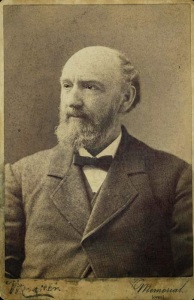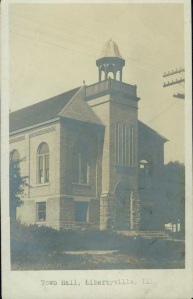In the nineteenth century a well-known Chicago architect was commissioned to design buildings in Libertyville, most likely through his association with Ansel B. Cook. Mr. Cook of course, was a town dignitary and the benefactor of the Cook Memorial Library and Cook Park. In the 1850s he was a successful stone mason and building contractor. Ansel Cook laid the first flagstone sidewalks in Chicago and held the masonry contract for the Chicago Water Tower pumping station. This station, a landmark on Michigan Avenue today, was designed by noted architect William W. Boyington. No doubt the collaboration between Mr. Boyington (below, left) and Mr. Cook (below, right) sealed their friendship through a mutual love of construction and design.


William W. Boyington was born in Massachusetts, but he learned his trade as a young man in New York. He trained first as a carpenter, then studied engineering and architecture. He practiced in New York and served in the state legislature before he was drawn to the burgeoning metropolis of Chicago. Throughout the nineteenth century Mr. Boyington designed many notable buildings in Illinois. The new Illinois State Capitol building, Joliet Prison and the entrance to Rosehill Cemetery are still-standing examples of his work.
In 1868, about the same time as the Water Tower construction, W. W. Boyington designed a new church for Libertyville. The Union Church Movement originated after the Civil War as an early ecumenical movement. Such churches were often built in small communities, offering people from different religious traditions the opportunity to join together and worship as a community.
In Libertyville, Presbyterian, Methodist, Congregational and Universal groups combined their resources to build a church on Church Street west of Milwaukee Avenue. Pictured above, the tall, stately Union Church was a fixture in town until it was destroyed by fire in 1916. Later, St. Lawrence Episcopal Church was built in its place.
Around 1870, Mr. Cook bought a tract of land from his father-in-law Dr. Foster that included all of what is now Cook Park. Although documented proof is yet to be found, it is thought that Mr. Boyington had a hand in designing the Ansel B. Cook house and the original gardens that graced the property on Milwaukee Avenue.

William Boyington’s last commissioned project was our old town hall, still standing at 715 N. Milwaukee Ave. At the time, Ansel Cook was chairman of the village’s building committee and he joined forces with Mr. Boyington to construct the Romanesque structure in April 1894. For many years the town hall was used for meetings, lectures, entertainment and Lake County political conventions. The American Legion bought the building in 1982 when the Libertyville Township offices vacated the site and opened a new office on Merrill Court. In 1996 a metal replica of the original wooden cupola was set in place. A 2002 restoration removed about 26 layers of paint from the exterior brick and stone, restoring the original surface.
The next time you drive down Milwaukee Avenue through Libertyville, observe the buildings erected by Boyington and Cook and remember their interesting architectural legacy.
Discover more from Cook Memorial Public Library District
Subscribe to get the latest posts sent to your email.